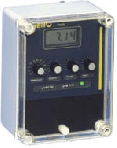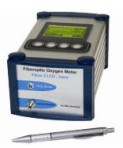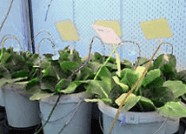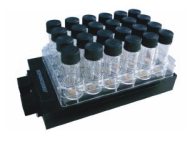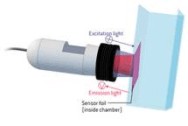



O2/CO2 Measurement
other analyser, for gas here: Gas Analysis
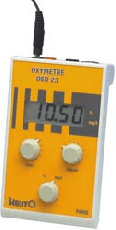 |
Oxy-Meter OSD 23
|
||||||||||||||||||||||||||||||||||||||||||||||||
|
|
Oxy-Meter OXM200
|
||||||||||||||||||||||||||||||||||||||||||||||||
Blind transmitter 4-20 mA (for O2)
|
|||||||||||||||||||||||||||||||||||||||||||||||||
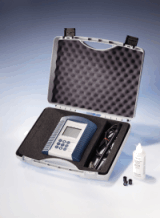 |
Oxy-Meter SensoDirect Oxi200
|
||||||||||||||||||||||||||||||||||||||||||||||||
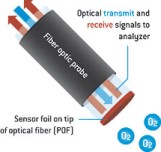
|
PreSens Sensor Spot, non invasiv O2 sensorthey are attached to the inner surface of any transparent vessel. Differents dyes are included in a matrix. A detector measures the modification of the fluorescence emmited from the dye depending on the O2 concentration. for shake flask, tubes, petri dishes, cultivation bags, wine. O2 measurement without contact. advantages
specifications
reader Fibox LCD V7
|
||||||||||||||||||||||||||||||||||||||||||||||||
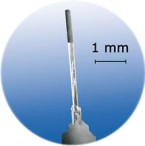
|
Micro O2-probesensor tip diameter smaller as 150 um no need of reference electrode different types
applications
specifications
one channel Transmitter: Microx 4 or Microx 4 trace
|
||||||||||||||||||||||||||||||||||||||||||||||||
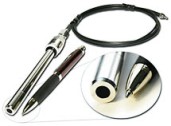
|
O2 probeThe oxygen probe for in-line measurement (OIM) consists of a fitting made of stainless steel with an optical exchange cap (OEC). The in-line measurement is connected to the instrument via an optical fiber. It has a standardized thread and length and is compatible with most bioreactors and port adapters. In addition, customized fittings for e. g. sight glasses are offered specifications
one channel Transmitter: Fibox 3/Fibox 3 trace, Fibox 3 LCD/Fibox 3 LCD trace, Fibox 4, Fibox 4 trace multi-channel Transmitter, for 4 or 10 probes: OXY-4/10 mini & OXY-4/10 trace.
|
||||||||||||||||||||||||||||||||||||||||||||||||
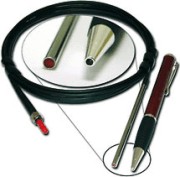
|
O2 diping probeThe steel tube has an outer diameter of 4 mm and a length of 10 cm. The diameter of the fiber itself is 2 mm. Due to the use of a polymer optical fiber, this probe is not compatible to temperatures higher than 70°C. one channel transmitters: Fibox 3/Fibox 3 trace, Fibox 3 LCD/Fibox 3 LCD trace, Fibox 4, Fibox 4 trace multi-channel fiber optic oxygen transmitters / Parallel monitoring of up to 10: OXY-4/10 mini & OXY-4/10 trace. application: this dipping probes for oxygen measurement does not consume oxygen. Due to their small dimensions they do not disturb the flow and mass-transport and consequently display the in-situ oxygen concentration. As minisensors from PreSens are long-term stable they can be implanted in soil for many years.
|
||||||||||||||||||||||||||||||||||||||||||||||||
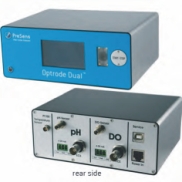 |
Optrode Dual ESC interface for oxgen and pH measurementIt converts the reading of chemical optical sensors to electrochemical signals (ECS). Connected to the electrode input of conventional controllers it expands their functionality to work with chemical optical sensors. In addition 4 - 20 mA outputs are integrated. Pre-calibration data for the chemical optical sensors can easily be entered via barcode. Temperature is compensated by a pre-set temperature or via the integrated temperature sensor. The Optrode Dual can be connected to any oxygen sensor type PSt3, and pH sensors type HP5 and HP8. It can replace for exemple a O2 probe in a fermenter. pH Optrode
O2 Optrode
Temperature measurement: 0-50 °C (Sensor: 4-wire, PT100, Class A) Can be used with Presens Sensor Spots O2 / pH, Flow-Through Cells O2 / pH, Oxygen Dipping Probe
|
||||||||||||||||||||||||||||||||||||||||||||||||
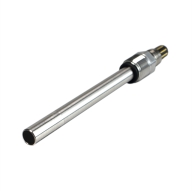 |
Oxygen Probe OXYPro® with 4-20 mA outputThe OXYPro® combine an optical sensor (type PSt7, PSt8, PSt6, PSt9) and electro-optical module in one probe. The sensors have a maximum measurement range of 0 - 20.9 % O2, 0-100 % O2, 0-10 % O2 ou 0-200 ppm % O2. They are integrated in a removable sensor cap (OEC), which can easily be exchanged. The mid-range OXYPro® are ideally suited for applications in the food & beverage sector, e. g. soft drink production or wineries. The exchange caps are not only available in a version safe for food applications, but also with fast response time, for measurements in aggressive environments, or for reduced air bubble formation on the sensor. The OXYPro® are directly connected to the control unit and have a standard PG 13.5 stainless steel thread for easy integration at the measurement site. As a digital interface these probes use RS485 (OXYPro® _R = PreSens proprietary, OXYPro® _RM = Modbus RTU) and have 4 - 20 mA analog output. A serial communication protocol is offered for data exchange between the OXYPro® and a PC or other host unit. For initial operation and adjustment of the 4 - 20 mA output the PreSens EOM-STS software can be used.
|
||||||||||||||||||||||||||||||||||||||||||||||||
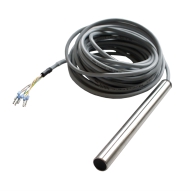 |
Oxygen Probe OXYBASE® with 4-20 mA outputThe OXYBase® WR-RS485-AO combines an optical sensor type PSt3 and electro-optical module in one probe. The sensor has a maximum measurement range of 0 - 100 % O2, and a detection limit of 0.03 % O2 / 20 ppb. As it is waterproof, this probe is ideally suited for e. g. measurements in aquaculture or environmental research projects. OXYBase® is connected directly to the control unit, uses RS485 as digital interface (PreSens proprietary) and has 4 - 20 mA analog output. A serial communication protocol is offered for data exchange between the OXYBase® and a PC or other host unit. For initial operation and adjustment of the 4 - 20 mA output the PreSens EOM-STS software can be used. The probe is available with various cable lengths, and its sensor is integrated in a removable sensor cap (OEC), which can easily be exchanged. These exchange caps are offered in different versions for certain demands (fast response time, safe for food applications, for aggressive environments, USP Class VI compatible). The sensor is not autoclavable.
|
||||||||||||||||||||||||||||||||||||||||||||||||
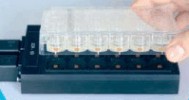 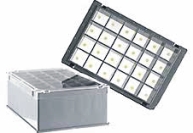
|
Oxygen measurement with OxoDish /SDRdetects O2 in multidishes non-invasively. These contain a sensor spot at the bottom of each well. They are read out non-invasively through the transparent bottom. It is available in the 24-well and 6-well format. It can be used in incubators and on shakers and is thus the ideal tool for cell cultivation. The SDR reader can also be used with Deep Well OxoDishes and glass vials (5 mL). The Deep Well OxoDishes are suitable for shaken cultures (bacterium, yeast, suspension cells, etc.) with a special adapter.
|
||||||||||||||||||||||||||||||||||||||||||||||||
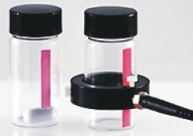 |
Oxygen measurement in vialsOnline oxygen monitoring in 20 ml SensorVials Special glass vials with integrated PSt3 oxygen sensor foil Measurement in liquid phase and headspace Vial Adapter for attaching of a polymer optical fiber (POF-2SMA) SensorVials for stirred and non-stirred applications available Pre-calibrated and autoclavable Compatible with any PreSens oxygen transmitter, e.g. Fibox 3, OXY-4 mini, and others Customer specific variation possible
|
||||||||||||||||||||||||||||||||||||||||||||||||
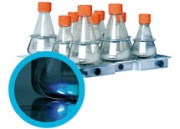 |
SFR Shake Flask ReaderThe SFR - Shake Flask Reader monitors oxygen and pH in up to 9 shake flasks simultaneously. It fits in nearly all standard shakers. The corresponding ready-to-use flasks contain pre-calibrated sensor spots. The system monitors non-invasively through the transparent bottom of the flask. Different types and sizes of flasks are available here. Plastic flasks contain pre-calibrated oxygen and pH sensors. They are ready-to-use for one cultivation. Glass flasks are equipped with autoclavable oxygen sesnors.
|
||||||||||||||||||||||||||||||||||||||||||||||||
 |
Oxygen Ingress MeasurementA new non-invasive and non-destructive fiber optic oxygen meter to determine oxygen permeability of plastic bottles and containers. The sensor spot can be glued into the PET bottle which then can be closed with a standard closure. For this direct coating, the bottles should be transparent but the measurement is even possible through slightly coloured (e. g. greenish or yellowish) or turbid bottles. To determine the oxygen ingress in dark brown or non-transparent PET bottles, a direct coating of the PET bottle wall with a sensor spot is not possible. To enable non-invasive oxygen ingress measurement also for deeply coloured and non-transparent containers PreSens has developed an oxygen-sensitive cap (OSC) which can be used as closure.
|
||||||||||||||||||||||||||||||||||||||||||||||||

|
PreSens Sensor Spot, non invasiv CO2 sensorthey are attached to the inner surface of any transparent vessel. Differents dyes are included in a matrix. A detector measures the modification of the fluorescence emmited from the dye depending on the CO2 concentration. for shake flask, tubes, petri dishes and cultivation bags. CO2 measurement without contact. advantages
specifications
|
||||||||||||||||||||||||||||||||||||||||||||||||
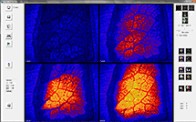
|
PreSens Imaging Solutions VisiSensMeasure and Visualize Oxygen distributions in 2D For measurement the sample surface is covered with the sensor film, which translates the oxygen or CO2 content into a light signal. The sensor response is recorded pixel by pixel with a digital camera. With VisiSens spatial and temporal changes of oxygen concentration can be monitored.
|
||||||||||||||||||||||||||||||||||||||||||||||||
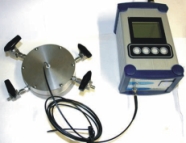 |
Permeation Testing of High Barrier Materialsnew system for testing materials on oxygen permeability unlike the other systems with electrochemical and barometrical sensors, this system uses optical measurement (Fibox LCD Trace) advantages
|
||||||||||||||||||||||||||||||||||||||||||||||||
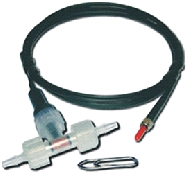 |
Flow-Through Cell O2The flow-through oxygen minisensor (FTC) is a miniaturized chemical optical sensor integrated in a flow-through cell. It is connected to the transmitter by an optical fiber. A glass tube with an inner diameter of 2 mm is coated with an optical oxygen sensor at its inner wall. The volume for liquid inside the FTC is about 100 (±10) microliter. The different flow-through cells can be easily connected via Luer-Lock adapters to external tubings to the Fibox (Ref. FTC) or to the Microx transmitters (Ref. FTCH and FTCM).
|
||||||||||||||||||||||||||||||||||||||||||||||||
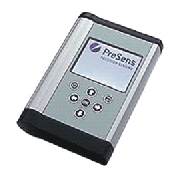 |
Fibox 4 and Fibox 4 Trace for oxgen measurementEasy calibration via barcode scan Compensation of temperature, pressure and salinity Energy management for long term measurements Optional database supported software offers simultaneous control of multiple devices The Fibox 4 works with sensor type PSt3 (detection limit 15 ppb dissolved oxygen, 0 - 100 % oxygen). With the Fibox 4 trace additionally trace and ultra low oxygen concentrations can be measured. It is compatible with sensors type PSt3, PSt6 (detection limit 1 ppb dissolved oxygen, 0 - 4.2 % oxygen), and PSt9 (detection limit 0.5 ppm, 0 - 200 ppm gaseous oxygen) The optical oxygen meters are compatible with the existing PreSens sensor portfolio. All PreSens oxygen sensors will be delivered with a barcode. With the oxygen meters´ integrated barcode reader sensor identification and calibration can be realized by performing just one scan, and measurements can be started immediately. A new sensor management system has been implemented where data of up to 100 sensors can be stored. This ensures a fast work flow while conducting most precise oxygen measurements.
|
||||||||||||||||||||||||||||||||||||||||||||||||
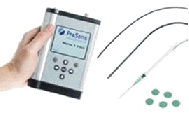 |
Microx 4 & Microx 4 Trace for oxgen measurementFor use with non-invasive sensors, probes & microsensors Straightforward measurement due to unique sensor ID Simple calibration via barcode scan Compensation of temperature, pressure and salinity Energy management for long term measurements Optional database supported software offers simultaneous control of multiple devices The oxygen meters are compatible with non-invasive sensors & probes (type PSt7-10, PSt8-10) and oxygen microsensors (type PSt7-02, PSt8-02). The sensors are available as sensor spots, for integration in vessels, dipping probes, flow-through cells, oxygen microsensors integrated in syringe canulas, for piercing container walls or tissue, or bare fiber microsensors, which can be used in customized applications. All sensors will be delivered with a barcode. With the oxygen meters´ integrated barcode reader sensor recognition and calibration can be done in just one scan. The implemented sensor management system allows storing data of up to 100 sensors.
|
||||||||||||||||||||||||||||||||||||||||||||||||
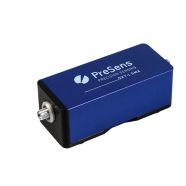 |
OXY-1 SMA and OXY-1 SMA-Trace for oxygen measurementThis device works like the Fibox 4, but it needs to be connected to a computer to read the data. Due to its small outer dimensions it can be set up almost anywhere. It is compatible with non-invasive sensors, dipping probes and flow-through cells of type PSt3 and PSt6 (depending on the version). The device has a temperature compensation (it is possible to connect ane xternal temperature sensor, or enter the temperature in the software interface), so most precise measurements in environments with changing temperature can be taken. This USB-powered oxygen meter is operated with the PreSens Measurement Studio 2 software (included), which enables simultaneous control of several devices, so measurement networks can be set up. With numerous features and additional pressure and salinity compensation, the software makes the OXY-1 SMA suitable for almost any application where precise oxygen measurements are needed.
|
||||||||||||||||||||||||||||||||||||||||||||||||
 |
OXY-1 ST and OXY-1 ST-Trace for oxygen measurementThis device works like the Microx 4, but it needs to be connected to a computer to read the data. This extremely small oxygen meter can be used with microsensors (200 µm fiber) in different designs, non-invasive sensors, dipping probes and flow-through cells (1 mm fiber). It is is compatible with sensor type PSt7 and PSt8 (depending on the version). It is operated with the PreSens Measurement Studio 2 software and offers temperature, pressure and salinity compensated measurements. The software has numerous features and allows to control several OXY-1 ST simultaneously. Powered via USB no extra cables or adapters are needed. This oxygen meter is the solution for most precise micro-invasive or non-invasive measurements.
|
||||||||||||||||||||||||||||||||||||||||||||||||
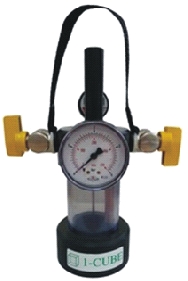 |
CO2 measurement device in beer GMAsThe measuring device makes it possible to measure CO2 content in fermenting tanks, KEG casks and cylindro-conical fermenters (volume percentage or g/l). CO2 content is determined thanks to the measurement of the balance value of temperature and pressure after the mechanical fluttering of CO2 dissolved in beer. CO2 content is read on a nomogram, part of measuring device supply. The operator fills a vessel by measured sample of beer (with the help of ball valves). Fluttering is made by shaking the device. After attaining a balance the operator can read the balance value of the pressure and the temperature. CO2 content can be read on the nomogram. You can modify the formula for the calculation of the CO2 content in specific drinks.
The device can be adapted to other beverage.
|
||||||||||||||||||||||||||||||||||||||||||||||||
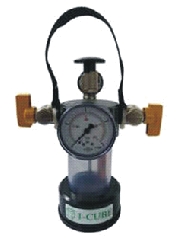 |
CO2 measurement device in beer GMAThe operator fills a vessel by measured sample of beer (with the help of ball valves). Fluttering is made thanks to the repeated depression of a button with arrestment placed on the top of device. After attaining a balance the operator can read the balance value of the pressure and the temperature. CO2 content can be read on the nomogram. You can modify the formula for the calculation of the CO2 content in specific drinks.
The device can be adapted to other beverage.
|
||||||||||||||||||||||||||||||||||||||||||||||||
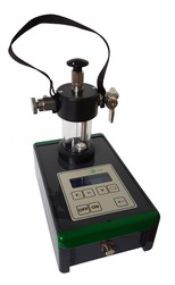 |
CO2 measurement device in beer GMDThe device for determination of CO2 content is based on the Henry law principle. The CO2 content is determined with the help of measurement of balanced value of temperature and pressure after the mechanical fluttering of CO2 dissolved in beer. Preceding the measurement the operator puts the button to flutter the CO2 in a low position and connects the device with the help of the rubber hose to cylindro-conical fermenter tank or to the fermenting or to the supplied adapted head attached to the KEG cask. This head makes it possible to attain the necessary overpressure in a KEG cask thus securing the samples withdrawal. The operator with the help of the closing valves fills a carefully measured vessel with the measured beer sample. Fluttering is done with the help of depressing the arrestment button - that is placed on the top of the device. You switch on the device by depressing the "ON" button on the membrane keyboard. The value of the CO2 content can be watched on a display after depression of the "enter" button in CO2 menu. The device cleaning after the measurement is easy and fast.
Version GMDK: with USB connector and software for data transfer to a computer. The device can be adapted to other beverage.
|
||||||||||||||||||||||||||||||||||||||||||||||||
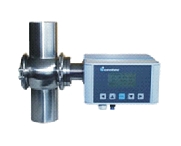 |
Carbotec TR-PT in-line CO2-transmitterIt measures continuously and exactly the content of carbon dioxide in carbonated liquids. For determining the CO2-content of a carbonated liquid, every 13 seconds a 30ml sample is isolated from the main stream. The pressure of this taken sample is abruptly reduced to below atmospheric pressure. The resultant pressure will differ from that of a non-carbonated liquid according to the volume of dissolved CO2 in the sampled liquid. This difference in resulting pressure is the basis for calculating the CO2-content of the liquid. The temperature dependence of the measurement signal is electronically compensated by PT100. After the measurement the sample is returned to the beverage line. The CO2-concentration can be displayed in different units like g/l, v/v, bar (20°C), ml/l, % or cc/kg.
|
||||||||||||||||||||||||||||||||||||||||||||||||
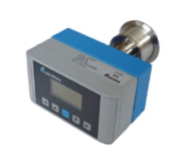 |
Carbotec NIR in-line CO2-transmitterIt measures continuously and exactly the content of carbon dioxide in carbonated liquids. While transmitting a sapphire crystal, infrared light is reflected at the crystal surface which is in contact to the carbonated liquid. The CO2 molecules absorb the light and decrease the intensity. By intensity measurement, 'true' CO2 content is determined. CARBOTEC NIR can be used to detect carbon dioxide even when CO2 is not the only gas in the liquid. Without any moving parts in the sensor head, the new generation of CO2 sensors is virtually maintenance free.
|
||||||||||||||||||||||||||||||||||||||||||||||||
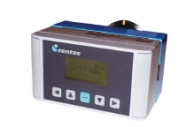 |
OXYTRANS TR in-line O2-transmitterthis device is used in various industries all around the world. Breweries and soft drink manufacturers determine the O2 content in deaerated water and beverages with OXYTRANS. Oxygen measurement during fermentation is an ideal application. Numerous power plants use the sensor to monitor oxygen levels in their boiler water. The state of the art optical measurement technology is based on the effect of luminescence quenching, i.e. the radiationless redistribution of excitation energy via a molecular interaction. An indicator layer on a small glass component ('optical window') installed in the measuring head is illuminated with blue-green-light. When the indicator molecules absorb the incident light they are promoted to a higher energy state. After a certain time they convert back to their ground state during which a detectable red light is emitted. If O2 is present the energy is transferred from the indicator molecules to the oxygen. The detected signal decreases according to the oxygen content. OXYTRANS displays various units, e.g. ppb, ppm and % oxygen. The lightweight portable device is very robust and can easily be connected with hoses.
|
||||||||||||||||||||||||||||||||||||||||||||||||
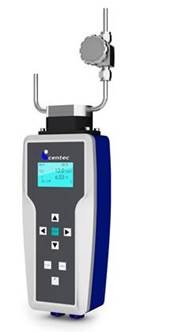 |
OXYTRANS M portable O2-MeasurementIt is a portable, optical oxygen sensor for measurement of O2 in liquids and gases. A typical application is the oxygen measurement in boiler feed water and in protective atmospheres. Electrolyte solutions are not necessary and no oxygen is consumed during the measurement. The optical measurement technology is based on the effect of luminescence quenching, i. e. the radiationless redistribution of excitation energy via molecular interaction. In the measuring head a small glass component with a thin layer of indicator molecules is installed, the optical window. The indicator molecules are illuminated with blue-green light produced by an LED in the oxygen sensor. They absorb the incident light and are promoted to a higher energy state. After a certain time the molecules convert back to their ground state, during which red light is emitted. The red light is detected inside in the sensor. If O2 molecules are present the energy is transferred from the excited indicator molecules to the oxygen. This molecular interaction causes the excitation energy to be redistributed without any resultant radiation. The detected signal decreases with increasing concentration of oxygen molecules in the product. Any temperature drifts of the measured signal are automatically compensated for by an internal Pt100 sensor.
|
||||||||||||||||||||||||||||||||||||||||||||||||
Oberdorfstrasse 51
CH 3930 Eyholz
tel + 41 27 946 80 18
fax + 41 27 946 86 42
info@sysmatec.ch
